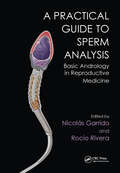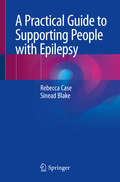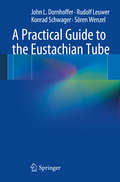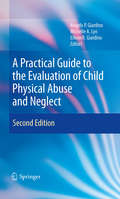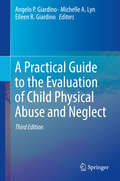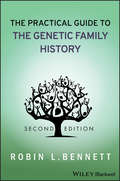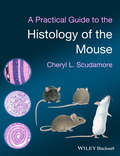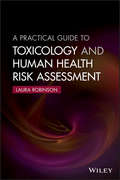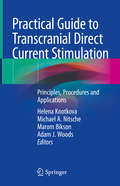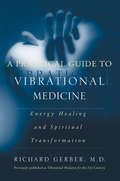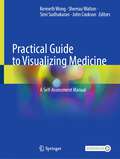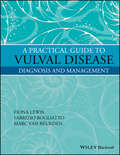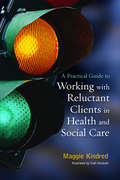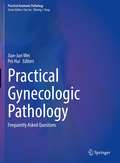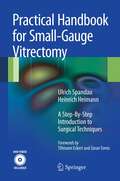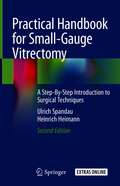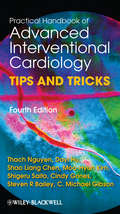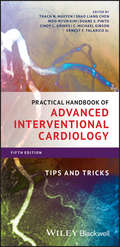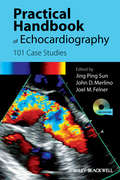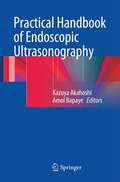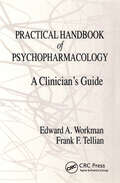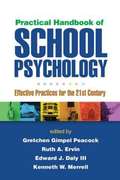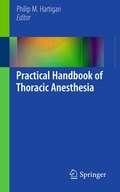- Table View
- List View
Practical Guide to Sperm Analysis: Basic Andrology in Reproductive Medicine
by Nicolás Garrido Rocio RiveraThis is a reference manual for daily use in the Reproductive Medicine or Andrology laboratory, which goes beyond the literature available in the scientific journals by compiling insights into a detailed and applied clinical approach. All established practitioners in Reproductive Medicine will find much of practical relevance about the latest insights into sperm selection and analysis.
A Practical Guide to Supporting People with Epilepsy
by Rebecca Case Sinead BlakeThis book is a practical guide, with rationale to supporting people with epilepsy. It encompasses epilepsy guidance such as NICE (2012, revised 2019), The Equality Act (2010), the children and families act (2014), current evidence based-practice, and regulatory organisation standards. It is predominantly aimed at nurses and student nurses, especially, those studying learning disability nursing but also residential, respite and supported living services, schools and family carers, to enable them to offer appropriate and evidence-based support to people with epilepsy of all ages. It is estimated there are approximately 1200 epilepsy related deaths each year in the UK. Many of these are considered to be preventable. High-profile cases have led to an increase in anxiety in people providing services, and greater scrutiny of those services by regulatory bodies. Over the years, the authors have been asked the same questions and witnessed the same misunderstandings and mistakes, by people supporting individuals with epilepsy. So they looked at the common themes and the resources available. It became clear that the information to address these gaps is available, but not easily accessible. There is lots of information in the public domain, however much of it is factual, rather than practical. This book provides practical information and resources with the focus on “what needs to happen”,” how to make it happen” and “who needs to do it”. This book is useful for supporting people with epilepsy wherever they live (both within and outside the United Kingdom).
A Practical Guide to the Eustachian Tube
by John L. Dornhoffer Rudolf Leuwer Konrad Schwager Sören WenzelThis book, written by international experts, is a detailed guide to the Eustachian tube, with emphasis on those aspects of most relevance to the practitioner. The opening chapters document the clinical anatomy and provide essential information on physiology, with explanation of the new model of tubal mechanics. Diagnosis and therapy for the patulous Eustachian tube are then discussed, placing special emphasis on a novel conservative treatment regimen that has proven to be a breakthrough for patients with this clinical syndrome. A further extensive chapter examines overall function of the Eustachian tube, primarily from the middle ear surgeon's viewpoint. Tuboplasty procedures, including laser tuboplasty, and tympanoplasty are described, and the implications of different middle ear pathologies for surgical treatment are explained. The previously unpublished treatment methods that are described in this book will be invaluable in ensuring the best possible clinical outcomes.
A Practical Guide to the Evaluation of Child Physical Abuse and Neglect
by Angelo P. Giardino Eileen R. Giardino Michelle A. LynTo keep up with growing body of professionals staying informed on this subject, the second edition of A Practical Guide to the Evaluation of Child Physical Abuse and Neglect assists the reader in recognizing abuse/neglect (exclusive of sexual abuse) in children and youth, and determining its extent. Illustrated with clinical photographs, the Guide details systematic evaluation procedures, explains the tasks of an evaluation team, and expands and updates the knowledge base in these and other major areas: Specific injuries, including burns, bruises, fractures, head and abdominal injuries. Malnourishment and other forms of neglect. Medical child abuse (previously known as Munchausen Syndrome by Proxy). Maltreatment of children with special health care needs. Domestic partner violence. Prevention strategies, psychosocial assessment, collaborations with law enforcement and the courts, and more. The new edition of the Practical Guide to the Evaluation of Child Physical Abuse and Neglect offers expert information.
A Practical Guide to the Evaluation of Child Physical Abuse and Neglect
by Angelo P. Giardino Michelle A. Lyn Eileen R. GiardinoThe impact of child maltreatment on victims, families, and society—from immediate medical care and legal services to long-term mental health care and law enforcement—cannot be understated. And it remains a severe problem in spite of increasing public awareness and stricter laws. To keep up with growing body of professionals staying informed on this subject, the third edition of A Practical Guide to the Evaluation of Child Physical Abuse and Neglect assists the reader in recognizing abuse/neglect (exclusive of sexual abuse) in children and youth, and determining its extent. Illustrated with clinical photographs, the Guide details systematic evaluation procedures, explains the tasks of an evaluation team, and expands and updates the knowledge base in these and other major areas:Specific injuries, including burns, bruises, fractures, and head and abdominal injuriesMalnourishment and other forms of neglectMedical child abuse (previously known as Munchausen Syndrome by Proxy)Maltreatment of children with special health care needsDomestic partner violencePrevention strategies, psychosocial assessment, collaborations with law enforcement and the courts, and moreThe new edition of A Practical Guide to the Evaluation of Child Physical Abuse and Neglect offers expert information useful to practitioners across professional domains: public health professionals in maternal and child health and school settings; physicians and nurses; clinical social workers, child psychologists, and school psychologists; and attorneys and law enforcement personnel.
The Practical Guide to the Genetic Family History
by Robin L. BennettHelps you develop and assess pedigrees to make diagnoses, evaluate risk, and counsel patientsThe Second Edition of The Practical Guide to the Genetic Family History not only shows how to take a medical-family history and record a pedigree, but also explains why each bit of information gathered is important. It provides essential support in diagnosing conditions with a genetic component. Moreover, it aids in recommending genetic testing, referring patients for genetic counseling, determining patterns of inheritance, calculating risk of disease, making decisions for medical management and surveillance, and informing and educating patients. Based on the author's twenty-five years as a genetic counselor, the book also helps readers deal with the psychological, social, cultural, and ethical problems that arise in gathering a medical-family history and sharing findings with patients.Featuring a new Foreword by Arno Motulsky, widely recognized as the founder of medical genetics, and completely updated to reflect the most recent findings in genetic medicine, this Second Edition presents the latest information and methods for preparing and assessing a pedigree, including:Value and utility of a thorough medical-family historyDirected questions to ask when developing a medical-family history for specific disease conditionsUse of pedigrees to identify individuals with an increased susceptibility to cancerVerification of family medical informationSpecial considerations when adoptions or gamete donors are involvedEthical issues that may arise in recording a pedigreeThroughout the book, clinical examples based on hypothetical families illustrate key concepts, helping readers understand how real issues present themselves and how they can be resolved.This book will enable all healthcare providers, including physicians, nurses, medical social workers, and physician assistants, as well as genetic counselors, to take full advantage of the pedigree as a primary tool for making a genetic risk assessment and providing counseling for patients and their families.
A Practical Guide to the Histology of the Mouse
by Cheryl L. ScudamoreA Practical Guide to the Histology of the Mouse provides a full-colour atlas of mouse histology. Mouse models of disease are used extensively in biomedical research with many hundreds of new models being generated each year. Complete phenotypic analysis of all of these models can benefit from histologic review of the tissues.This book is aimed at veterinary and medical pathologists who are unfamiliar with mouse tissues and scientists who wish to evaluate their own mouse models. It provides practical guidance on the collection, sampling and analysis of mouse tissue samples in order to maximize the information that can be gained from these tissues. As well as illustrating the normal microscopic anatomy of the mouse, the book also describes and explains the common anatomic variations, artefacts associated with tissue collection and background lesions to help the scientist to distinguish these changes from experimentally- induced lesions.This will be an essential bench-side companion for researchers and practitioners looking for an accessible and well-illustrated guide to mouse pathology.Written by experienced pathologists and specifically tailored to the needs of scientists and histologistsFull colour throughoutProvides advice on sampling tissues, necropsy and recording dataIncludes common anatomic variations, background lesions and artefacts which will help non-experts understand whether histologic variations seen are part of the normal background or related to their experimental manipulation
A Practical Guide to Therapeutic Communication for Health Professionals
by Julie Hosley Elizabeth Molle-MatthewsThis new textbook is designed to provide students with all the necessary tools to effectively communicate with patients and other health care professionals. With its easy-to-read style, it is loaded with useful tips to help students engage into the practice of communication. <p><p>It presents condensed amounts of content for learning the basic principles and then integrating elements such as case scenarios, questions, or hints and tips to encourage application of those principles into real-life situations.
A Practical Guide to Toxicology and Human Health Risk Assessment
by Laura RobinsonToxicology – the study of the adverse effects of chemicals on living organisms is the cornerstone to all aspects of chemical safety and knowledge of the subject is needed in a wide spectrum of fields from the chemical industry to medicine, emergency services, forensics, and regulatory science. Toxicology involves the study of symptoms, mechanisms, treatments and detection of poisoning ... especially the poisoning of people.The many problems arising from a poor understanding of toxicology and its applications in hazard communication and chemical safety motivated the author’s training courses and webinars, leading to this valuable book.Providing a practical and accessible guide, A Practical Guide to Toxicology and Human Health Risk Assessment enables readers to quickly build up knowledge and understanding of toxicology and its use in hazard identification, which is a fundamental part of chemical risk assessment. The book also covers current toxicological testing strategies and the use of physicochemical test data in hazard identification and exposure assessment.Examples are provided throughout the book to highlight important issues along with a summary of the key points that have been covered in each of the respective chapters. The book concludes with a listing of online resources on toxicology and risk assessment.
Practical Guide to Transcranial Direct Current Stimulation: Principles, Procedures and Applications
by Helena Knotkova Michael A. Nitsche Marom Bikson Adam J. WoodsThis book provides a comprehensive overview on Transcranial Direct Current Stimulation (tDCS) and the clinical applications of this promising technique. Separated into three parts, the book begins with basic principles, mechanisms and approaches of tDCS. This is followed by a step-by-step practicum, methodological considerations and ethics and professional conduct pertaining to this novel technique. Chapters are authored by renowned experts who also direct and plan tDCS educational events worldwide. Bridging the existing gap in instructional materials for tDCS while addressing growing interest in education in this field, professionals within a broad range of medical disciplines will find this text to be an invaluable guide.
A Practical Guide to Vibrational Medicine
by Richard GerberAt the dawn of the 21st century, the old paradigms of medicine have begun to fall apart. We no longer believe that our bodies are machines with parts that wear down, only to be braced up by drugs or replaced through surgery. Instead, a growing number of pioneering researchers embrace a new view of healing – one expounded by Dr. Richard Gerber in his groundbreaking best–seller, Vibrational Medicine. Now he shows how to put this new way of thinking into practical use, describing the role of consciousness and "thought forms," as well as the benefits of homoeopathy, acupuncture, colour and light healing, magnetobiology, and other therapies. A traditionally trained physician, Dr. Gerber combines scientific evidence with traditional methods from the East and West to unlock our potential for healing ourselves.
Practical Guide to Visualizing Medicine: A Self-Assessment Manual
by Kenneth Wong Shernaz Walton Simi Sudhakaran John CooksonThis book provides a practically orientated resource that details the use a range of imaging techniques across major specialties plus those that are less well represented in standard textbooks (e.g. cardiothoracic surgery, palliative care, geriatric medicine, skin conditions from diverse ethnic groups). Emphasis is placed on enabling the reader to interpret images and clinical data, while avoiding mistakes and pitfalls in their day-to-day practice. Detailed question and answer sections along with insightful videos reinforce key messages (e.g. visualizing heart murmurs). Grading of questions aids navigation, with more difficult questions to benefit the high-flying students/junior doctors preparing for postgraduate exams/physician associates and advanced nurse practitioners working in a specialist area.Practical Guide to Visualizing Medicine: A Self-Assessment Manual concisely covers how to use imaging techniques in medicine, surgery, pediatrics, obstetrics and gynecology. It emphasizes the value of being able to accurately visualize signs and symptoms to make accurate diagnoses and provide patient-centered care. The added insight given from experienced medical educators on how to select an appropriate medical specialty makes this work critical for all trainee and early-career medical practitioners and allied healthcare professionals.
A Practical Guide to Vulval Disease: Diagnosis and Management
by Fabrizio Bogliatto Fiona M. Lewis Marc Van BeurdenThis book is a practical guide to the diagnosis and management of vulval disorders. It offers guidance for all those who are treating patients with vulval disease at trainee and specialist level, helping to improve management for the patient and prevent delays in diagnosis, including referrals to specialists. It contains key information about diagnosis, investigation and basic management, with a section on signs and symptoms guides the reader to the correct chapter for the treatment of that disease. The experienced authors include updated classification and terminology of vulval disease with an explanation of how this should be useful in clinical practice and guidance as to when the patient should be referred on to a specialist. As vulval diseases are different to those of the rest of the skin patients with vulval disease present a large unmet need, often with delays in diagnosis due to a lack of training from physicians. This practical guide provides the specialist knowledge required for diagnosis and treatment of these conditions.
A Practical Guide to Working with Reluctant Clients in Health and Social Care
by Maggie KindredPractitioners in health and social care are often required to work with clients who do not want to work with them, and these 'reluctant' clients can often be the most challenging, but most rewarding, to work with. This practical, jargon-free book covers all the issues that practitioners are likely to encounter in the course of working with reluctant clients. The emphasis is on making theory easy to use, and the book is written in an easily digestible and lively style. Topics covered include staying safe, verbal and non-verbal communication, making initial contact with a client, crisis situations, recording, and how to end work with a client. Activities to work through are included at the end of each topic and illustrations feature throughout. This is an essential book for students, practitioners, voluntary sector workers and trainers in the fields of health, social care and social work.
Practical Gynaecological Ultrasound
by Jane BatesDevoted solely to gynecological ultrasound, this book covers normal anatomy and physiology as well as pathological processes. With excellent diagrams and halftones it illustrates the key technical and diagnostic steps needed by both the trainee and established radiographer, radiologist and gynecologist, providing clear guidance on the optimum management of patients undergoing gynecological investigation by ultrasound. Key topics include: normal anatomy and physiology; pathology of the uterus, ovaries and related pelvic structures; the acute pelvis; ovarian screening; infertility; pediatric gynecological ultrasound; and management of the gynecological patient.
Practical Gynecologic Pathology: Frequently Asked Questions (Practical Anatomic Pathology)
by Pei Hui Jian-Jun WeiThis book serves as a quick review or summary of major diagnostic challenges in gynecologic pathology and embraces a Q/A format by providing the desired diagnostic knowledge. It combines the diagnostic approach as it relates to morphology and the relevant ancillary tests which impact on clinical outcome or management. Each topic is written by subspecialty gynecological pathologists in the field in making this a valuable book for a broad spectrum of readers, particularly pathology trainees, junior pathologists and general practicing pathologists. These authors provide concise and accurate answers for a variety of common, yet challenging diagnostic scenarios that are relevant and frequently encountered in daily practice. The book walks readers through current topics, controversies and diagnostic dilemmas for common gynecologic diseases with morphologic features and key ancillary tests, richly illustrated with figures and tables. To reflex the current advances in diagnostic gynecological pathology, the topics are closely correlated with the updated disease classifications and diagnostic criteria, particularly those recognized by the World Health Organization. Practical Gynecologic Pathology provides a concise summary and review for some of the most difficult, prevailing and emerging concepts in gynecologic pathology.
Practical Handbook for Small-Gauge Vitrectomy
by Ulrich Spandau Heinrich HeimannSince the development of 23G vitrectomy in 2004, the technique has revolutionized retinal surgery by overcoming a number of the problems associated with 20G and 25G systems and offering significant improvements in surgical capability and fluidics. This important book first discusses the instruments and equipment employed in 23G vitrectomy and then explains, step by step, the various surgical techniques with the aid of informative diagrams and many high-quality photos. In addition, videos are included that document the different procedures, from the straightforward to the demanding. This book will serve as an immensely useful guide for all surgeons who are intending to make use of this exciting and increasingly used technique.
Practical Handbook for Small-Gauge Vitrectomy: A Step-by-step Introduction To Surgical Techniques
by Ulrich Spandau Heinrich HeimannSince publication of the first edition of this book in 2012 vitreoretinal surgery has marched with huge steps forward. In 2012 23G was standard, today 25G and 27G are the most commonly used gauge sizes for vitrectomy. In 2012 the cutting rate was 5.000 cuts/min and today with the development of a novel vitreous cutter the cutting rate has increased to 16.000 cuts/min. The advent of 25G/27G made the instruments smaller and surgery less traumatic. Practical Handbook for Small-Gauge Vitrectomy: A Step-By-Step Introduction to Surgical Techniques, 2ndEdition focuses on these new developments and features new chapters on PVR detachment, intraocular tumour, macular translocation, sub macular hemorrhages and ocular trauma. The surgeries are demonstrated step-by-step and the material is shown in detail and videos visualize the surgery.This book will serve as an immensely useful guide for all surgeons who are intending to make use of this exciting and increasingly used technique.
Practical Handbook of Advanced Interventional Cardiology
by Steven R. Bailey Shigeru Saito Cindy Grines C. Michael Gibson Shao Liang Chen Thach Nguyen Dayi Hu Moo-Hyun KimContinued advances in cardiology have led to unprecedented scientific progress in recent years. However, no matter how advanced the science, the successful application of interventional cardiology relies upon a practitioner's ability to approach interventional techniques competently and confidently in every situation. Fully updated and featuring new chapters and additional tips and tricks, this latest edition of Dr Nguyen, Colombo, Hu, Grines, and Saito's celebrated book provides a complete yet concise guide to practical interventional cardiology that deserves a place in every cardiac laboratory. Culled from the personal experience of over fifty international experts, the book incorporates more than 500 practical tips and tricks for performing interventional cardiovascular procedures. Each strategic or tactical move is graded by complexity level and described in a simple, step-by-step approach that includes guidance on how to overcome practical difficulties, providing a comprehensive resource that can benefit both beginner or experienced operators. As well as covering the latest developments in interventional cardiology, this third edition includes technical tips that promote user-friendly performance, low complication rates, cost- and time-efficient approaches and cost- and time-effective selection of devices to help optimize the practice of modern interventional cardiology.
Practical Handbook of Advanced Interventional Cardiology: Tips and Tricks
by Thach N. Nguyen Shao Liang Chen Moo-Hyun Kim Duane S. Pinto Cindy L. Grines C. Michael Gibson Ernest F. TalaricoA concise and convenient pocket guide to interventional cardiology’s latest procedures and technologies Interventional cardiology is growing more and more integral to the modern-day management of cardiovascular problems. Indeed, trainees are taught interventional methods as a matter of course. With a widening range of options open to them, however, the practicing cardiologist must be diligent and discerning when selecting the appropriate course of action for each patient, adapting their strategy as circumstance demands. Developing the skills and experience necessary to make these key judgments can be a challenging and lengthy process. Bringing together the knowledge of an international group of over 50 experts, this fifth edition of the Practical Handbook of Advanced Interventional Cardiology helps cardiologists of all levels to find interventional solutions to a wide range of problems. Its revised contents cover topics including new devices, valve procedures, and venous and atrial occlusion, and also feature new chapters on bioresorbable vascular scaffolds, protected percutaneous coronary intervention, coronary atherectomy, pulmonary embolism, and more. This essential companion: Offers clear, easy-to-follow guidance for cardiology practitioners of all levels of skill and experience Grades each strategic or tactical action by level of complexity Includes full-color clinical images and illustrations Covers all key interventional procedures and techniques Provides practical tips and tricks for handling difficult clinical scenarios and complications The Practical Handbook of Advanced Interventional Cardiology is an invaluable resource for both practitioners and trainees in interventional cardiology and all related areas of cardiovascular medicine.
Practical Handbook of Echocardiography: 101 Case Studies
by Jing Ping Sun Joel Felner John MerlinoPractical Handbook of Echocardiography: 101 Case Studies Echocardiography is now one of the most commonly used diagnostic imaging tools, yet many clinicians remain unaware of the range of conditions echo can reveal or how echo can be used to help plan therapy. Moreover, it can be quite challenging even for the most seasoned practitioners to spot unusual conditions. Compiled by three echocardiographers with more than 100 years of clinical experience between them, Practical Handbook of Echocardiography uses a case-based approach to explain in detail the full spectrum of echocardiographic modalities and how to optimize their use in the clinical setting. This practical new book: Covers the full gamut of echocardiographic modalities, including M-mode, 2-D,3-D and Doppler (PW, CW, color flow, tissue and strain), transesophageal (intra-operative and routine) and contrast Describes cases in both clinical and echocardiographic terms including very interesting cases and the new clinical techniques Features beautifully reproduced, well-labeled, full color echocardiograms Includes accompanying DVD with real-time video clips Appropriate for physician echocardiographers and all cardiologists, as well as echocardiographic technicians, Practical Handbook of Echocardiography is the ideal concise guide to using echocardiography to make definitive diagnoses and improve patient outcomes.
Practical Handbook of Endoscopic Ultrasonography
by Amol Bapaye Kazuya AkahoshiEndoscopic ultrasonography (EUS) has evolved from an obscure method of investigation in the 1980s to a distinct endoscopy subspecialty with interventional and therapeutic capabilities. The art of interpreting EUS images is a skill every endoscopist needs to master. This book helps to meet that need as it is concise, simple to read, and amply illustrated, and describes the technique in a step-by-step manner. Many high-resolution EUS images of diseases are included, and literature reviews are kept short and concise while separate discussions and illustrations are devoted to radial and linear techniques. The book can be used as a reference handbook in the endoscopy room, yet contains all of the relevant information required to perform EUS, interpret images, and reach a diagnosis. Important pathological conditions are thoroughly discussed using representative EUS images, pointing out salient differentiating features, and relevant literature reviews are included. The section on interventional EUS deals with advanced interventional or therapeutic procedures, and potential complications and methods to avoid them are discussed. For the novice, the book is designed to teach EUS using a step-by-step approach, and for the seasoned endosonographer it is a practical reference tool for use while performing EUS and may also serve in the differentiation of various pathologies.
Practical Handbook of Psychopharmacology: A Clinician's Guide
by Edward A. Workman Frank F. TellianPhysicians of the 1990s cannot afford to spend valuable time combing through volumes of laborious discussions of tedious details on psychiatric drugs. Practical Handbook of Psychopharmacology is the most comprehensive, yet user-friendly guide to psychotropic medication available in any single source. Text is minimized and straight to the point, with critical clinical information given in two forms. First, highly useful tables with the relevant basic information on all major psychotropic drugs are provided. The book also contains clinical flowcharts or tabular practice guidelines that assist in making everyday decisions about the use of psychotropics. Unique chapters discuss the psychopharmacology of pain, personality disorders, aggression, and children/adolescents, while other chapters cover standard areas such as depression, mania, psychosis, and dementia.
Practical Handbook of School Psychology
by Gretchen Gimpel Peacock Ruth ErvinBringing together leading authorities, this state-of-the-science handbook delves into all aspects of problem-solving-based school psychology practice. Thirty-four focused chapters present data-based methods for assessment, analysis, intervention, and evaluation, with special attention given to working in a response-to-intervention framework. Tools and guidelines are provided for promoting success in key academic domains reading, writing, and math. Social-emotional and behavioral skills are thoroughly addressed in chapters on self-management interventions, peer and family support, cognitive-behavioral interventions, medication use, and more. This accessible work is an invaluable reference for practitioners and an ideal resource for school psychology training programs.
Practical Handbook of Thoracic Anesthesia
by Philip M. HartiganThis comprehensive handbook delivers "bottom line," evidence-based guidance in the practice of thoracic anesthesia. Chapters are short and practical and include actionable technical pearls not available elsewhere. The editor and contributors are academic faculty who work at one of the busiest thoracic surgical programs in North America, and their aim has been to integrate essential concepts with practical decision-making. *Detailed guidance for performing more than 30 thoracic surgical procedures *Relevant surgical insights from a senior thoracic surgeon included for each procedure *Full range of modern thoracic anesthetic challenges covered *Essential foundation concepts digested and simplified *Technical aspects sufficiently detailed to be useful *An efficient resource for skilled generalists and trainees
